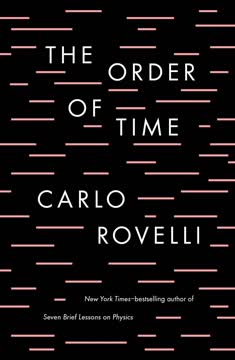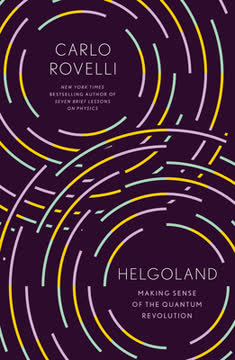Key Takeaways
1. Einstein's theory of general relativity revolutionized our understanding of space, time, and gravity
Einstein wrote an equation which says that R is equivalent to the energy of matter. That is to say: space curves where there is matter. That is it. The equation fits into half a line, and there is nothing more.
Gravity as curved spacetime. Einstein's groundbreaking insight was that gravity is not a force, but the curvature of spacetime itself. This elegant concept explains phenomena such as:
- Planetary orbits: Planets move in elliptical paths around the sun because they follow the natural curvature of spacetime created by the sun's mass.
- Light bending: Massive objects like stars can bend light rays passing near them, an effect observed during solar eclipses.
- Time dilation: Time passes more slowly in stronger gravitational fields, a phenomenon confirmed by precise atomic clocks at different altitudes.
Predictions and confirmations. General relativity made several startling predictions that have since been verified:
- Black holes: Regions of spacetime where gravity is so intense that nothing, not even light, can escape
- Gravitational waves: Ripples in spacetime caused by massive accelerating objects, detected for the first time in 2015
- Expanding universe: The theory's equations naturally led to the concept of an expanding universe, later confirmed by observations
2. Quantum mechanics unveiled the strange, probabilistic nature of the subatomic world
Heisenberg imagined that electrons do not always exist. They only exist when someone or something watches them, or better, when they are interacting with something else.
Wave-particle duality. Quantum mechanics revealed that subatomic entities like electrons and photons can behave as both particles and waves, depending on how they are observed. This led to counterintuitive concepts such as:
- Uncertainty principle: It's impossible to simultaneously know both the exact position and momentum of a particle
- Superposition: Particles can exist in multiple states simultaneously until observed
- Quantum tunneling: Particles can pass through barriers that classical physics says they shouldn't be able to
Probabilistic nature. Unlike classical physics, quantum mechanics deals with probabilities rather than certainties:
- Wave function: Describes all possible states of a quantum system
- Collapse of the wave function: Upon measurement, the system "chooses" one of the possible states
- Entanglement: Particles can become "entangled," with the state of one instantly affecting the other, regardless of distance
3. The cosmos: from a flat Earth to an expanding universe of billions of galaxies
The universe began as a small ball and then exploded to its present cosmic dimensions. This is our current image of the universe, on the grandest scale that we know.
Evolving cosmology. Our understanding of the universe has dramatically expanded over time:
- Flat Earth with sky above
- Spherical Earth at the center of the cosmos
- Heliocentric solar system
- Milky Way as one of many galaxies
- Expanding universe originating from the Big Bang
Current model. The modern cosmological model includes:
- Big Bang: The universe began as an extremely hot, dense state about 13.8 billion years ago
- Cosmic inflation: A period of rapid expansion in the early universe
- Dark matter and dark energy: Mysterious components that make up most of the universe's mass and energy
- Cosmic microwave background: Leftover radiation from the early universe, providing evidence for the Big Bang
4. Elementary particles: the building blocks of all matter and energy
Everything we touch is therefore made of electrons, and of these quarks.
Standard Model. The current theory of particle physics describes the fundamental particles and forces:
Particles:
- Quarks: Six types, combine to form protons and neutrons
- Leptons: Include electrons and neutrinos
- Bosons: Force-carrying particles like photons and gluons
Forces:
- Strong nuclear force: Binds quarks together
- Weak nuclear force: Responsible for radioactive decay
- Electromagnetic force: Interactions between charged particles
- Gravity: Not yet incorporated into the Standard Model
Quantum field theory. Particles are viewed as excitations of underlying quantum fields that permeate all of space. This framework helps explain phenomena like:
- Virtual particles: Fleeting particles that pop in and out of existence
- Particle-antiparticle pairs: Spontaneous creation and annihilation of matter and antimatter
5. Quantum gravity: the ongoing quest to unite general relativity and quantum mechanics
Loop quantum gravity is an endeavour to combine general relativity and quantum mechanics. It is a cautious attempt because it uses only hypotheses already contained within these theories, suitably rewritten to make them compatible.
The incompatibility problem. General relativity and quantum mechanics, while both highly successful in their domains, are fundamentally incompatible:
- General relativity: Describes gravity as smooth, continuous curvature of spacetime
- Quantum mechanics: Describes the world in terms of discrete quanta and probability
Approaches to quantum gravity:
- String theory: Proposes that fundamental particles are actually tiny vibrating strings in multiple dimensions
- Loop quantum gravity: Suggests that space itself is quantized into discrete units called "loops"
- Causal set theory: Models spacetime as a discrete set of events with causal relationships
Challenges and implications. Developing a theory of quantum gravity could:
- Explain the nature of black hole singularities
- Provide insights into the origin of the universe
- Unify all fundamental forces into a single framework
6. The nature of time: illusion or reality?
People like us, who believe in physics, know that the distinction made between past, present and future is nothing more than a persistent, stubborn illusion.
Time in physics vs. human experience. While we perceive time as flowing from past to future, physics presents a different picture:
- Block universe: In relativity, past, present, and future exist simultaneously
- No universal "now": The concept of simultaneous events breaks down in special relativity
- Reversibility: Many fundamental laws of physics are time-symmetric
Emergence of time's arrow. The apparent flow of time may emerge from:
- Thermodynamics: Increase in entropy gives a direction to time
- Quantum mechanics: Measurement and decoherence create apparent irreversibility
- Cosmology: Expansion of the universe provides a cosmic time direction
Open questions:
- What gives rise to our subjective experience of time?
- Is there a fundamental difference between past and future at the quantum level?
- How does time emerge in theories of quantum gravity?
7. Consciousness and free will: reconciling human experience with the laws of physics
There is not an 'I' and 'the neurons in my brain'. They are the same thing. An individual is a process: complex, tightly integrated.
The hard problem of consciousness. How does subjective experience arise from physical processes in the brain?
- Integrated Information Theory: Proposes that consciousness is a fundamental property of certain information-processing systems
- Global Workspace Theory: Suggests consciousness emerges from the broadcast of information across the brain
Free will in a deterministic universe. Reconciling our sense of free will with the deterministic laws of physics:
- Compatibilism: Free will is compatible with determinism if our actions stem from our own motivations and desires
- Libertarian free will: Proposes that quantum indeterminacy allows for true randomness in decision-making
Implications and reflections:
- Our decisions are the result of complex neural processes, not a separate "self"
- Consciousness and free will may be emergent properties of highly complex systems
- Understanding these phenomena could have profound implications for ethics, law, and our sense of self
Last updated:
FAQ
What's "Seven Brief Lessons on Physics" about?
- Overview of Modern Physics: "Seven Brief Lessons on Physics" by Carlo Rovelli provides a concise overview of the most significant developments in physics during the twentieth century.
- Seven Key Topics: The book is structured around seven lessons, each focusing on a fundamental aspect of modern physics, such as relativity, quantum mechanics, and the architecture of the cosmos.
- Accessible to All: It is written for readers with little to no background in science, aiming to make complex ideas comprehensible and engaging.
- Philosophical Insights: Beyond scientific concepts, the book also explores the philosophical implications of these discoveries on our understanding of reality and ourselves.
Why should I read "Seven Brief Lessons on Physics"?
- Simplifies Complex Concepts: Rovelli distills complex scientific theories into digestible lessons, making it an excellent introduction to modern physics.
- Broadens Understanding: The book offers insights into how the universe works, enhancing your appreciation of the natural world.
- Philosophical Reflection: It encourages readers to reflect on the philosophical questions raised by scientific discoveries, such as the nature of time and reality.
- Cultural Impact: As an international bestseller, it has been praised for its poetic and accessible approach to science, making it a cultural touchstone for understanding physics.
What are the key takeaways of "Seven Brief Lessons on Physics"?
- Relativity and Space-Time: Einstein's theory of general relativity revolutionized our understanding of gravity, showing that space and time are interconnected and dynamic.
- Quantum Mechanics: The book explains the probabilistic nature of quantum mechanics, where particles exist in states of probability rather than certainty.
- Cosmic Architecture: It describes the vast and complex structure of the universe, from galaxies to the potential existence of multiple universes.
- Human Perspective: Rovelli emphasizes that our understanding of physics also reshapes our understanding of ourselves and our place in the universe.
What are the best quotes from "Seven Brief Lessons on Physics" and what do they mean?
- "The most beautiful of theories": This refers to Einstein's general theory of relativity, highlighting its elegance and profound impact on our understanding of gravity and the cosmos.
- "Reality is not as it appears": This quote underscores the book's theme that scientific discoveries often reveal a world far different from our everyday perceptions.
- "We are made of the same stardust": This poetic expression emphasizes the interconnectedness of all matter in the universe, including humans, reinforcing the idea that we are part of a larger cosmic story.
- "The flow of time is an illusion": This challenges our intuitive understanding of time, suggesting that time may not be a fundamental aspect of reality as traditionally thought.
How does Carlo Rovelli explain Einstein's theory of relativity in "Seven Brief Lessons on Physics"?
- Space and Gravity: Rovelli explains that Einstein's theory shows gravity is not a force but a curvature of space-time caused by mass.
- Time Dilation: The theory predicts that time passes at different rates depending on the gravitational field, leading to phenomena like time dilation.
- Simple Equations: Rovelli highlights the simplicity and elegance of Einstein's equations, which describe how matter and energy influence the curvature of space-time.
- Impact on Physics: The theory of relativity has profound implications for our understanding of the universe, influencing everything from the motion of planets to the behavior of light.
What is quantum mechanics according to "Seven Brief Lessons on Physics"?
- Probabilistic Nature: Quantum mechanics describes the behavior of particles at the smallest scales, where outcomes are probabilistic rather than deterministic.
- Wave-Particle Duality: Particles like electrons exhibit both wave-like and particle-like properties, depending on how they are observed.
- Quantum Entanglement: Rovelli discusses phenomena like entanglement, where particles become interconnected in ways that defy classical understanding.
- Philosophical Implications: The theory challenges traditional notions of reality, suggesting that observation plays a crucial role in determining the state of a system.
How does "Seven Brief Lessons on Physics" describe the architecture of the cosmos?
- Expanding Universe: The book explains that the universe is expanding, a discovery that has reshaped our understanding of cosmic history.
- Galaxies and Stars: Rovelli describes the vast number of galaxies, each containing billions of stars, highlighting the scale and complexity of the cosmos.
- Curved Space: The universe is not flat but curved, with space-time being influenced by the mass and energy it contains.
- Big Bang and Beyond: The book touches on the origins of the universe with the Big Bang and speculates on the possibility of other universes.
What does Carlo Rovelli say about particles in "Seven Brief Lessons on Physics"?
- Elementary Particles: Rovelli explains that everything is made of a few types of elementary particles, such as quarks and electrons.
- Quantum Fields: These particles are excitations of underlying quantum fields, which are dynamic and constantly fluctuating.
- Standard Model: The book discusses the Standard Model of particle physics, which describes the fundamental forces and particles but also highlights its limitations.
- Dark Matter: Rovelli mentions the mystery of dark matter, which is not accounted for by the Standard Model but is essential for understanding the universe's structure.
What is loop quantum gravity as explained in "Seven Brief Lessons on Physics"?
- Combining Theories: Loop quantum gravity is an attempt to reconcile general relativity and quantum mechanics into a single coherent framework.
- Grains of Space: The theory suggests that space is not continuous but made up of discrete 'atoms' or 'grains' of space.
- No Absolute Time: It proposes that time is not a fundamental aspect of reality but emerges from the interactions of these space quanta.
- Experimental Challenges: While promising, the theory is still largely theoretical, with ongoing efforts to find experimental evidence.
How does "Seven Brief Lessons on Physics" address the concept of time?
- Time and Heat: Rovelli links the flow of time to thermodynamics, suggesting that time's arrow is related to the increase of entropy.
- Illusion of Flow: The book argues that the flow of time is an emergent phenomenon, not a fundamental aspect of reality.
- Relativity of Time: Time is not universal but relative, varying with speed and gravity, as shown by Einstein's theories.
- Philosophical Questions: Rovelli explores the philosophical implications of these ideas, questioning our intuitive understanding of past, present, and future.
What philosophical insights does Carlo Rovelli offer in "Seven Brief Lessons on Physics"?
- Interconnectedness: Rovelli emphasizes the interconnectedness of all things, suggesting that our understanding of the universe also informs our understanding of ourselves.
- Nature of Reality: The book challenges traditional notions of reality, proposing that what we perceive is only a small part of a much larger and more complex whole.
- Human Perspective: Rovelli reflects on the human place in the universe, suggesting that our knowledge and consciousness are part of the natural world.
- Curiosity and Knowledge: He celebrates human curiosity and the pursuit of knowledge as fundamental aspects of our nature, driving us to explore and understand the cosmos.
How does "Seven Brief Lessons on Physics" conclude on the topic of human existence?
- Part of the Universe: Rovelli concludes that humans are an integral part of the universe, made of the same elements and subject to the same laws as everything else.
- Ephemeral Nature: He reflects on the ephemeral nature of human life, suggesting that our awareness of mortality gives life its value.
- Curiosity and Exploration: The book celebrates human curiosity and the drive to explore, which have led to our understanding of the universe.
- Home in Nature: Rovelli emphasizes that nature is our home, and understanding it helps us understand ourselves and our place in the cosmos.
Review Summary
Seven Brief Lessons on Physics offers a concise, poetic overview of complex physics concepts for laypeople. Readers appreciate Rovelli's elegant writing and ability to explain difficult ideas, though some find it oversimplified. The book covers topics like relativity, quantum mechanics, and cosmology in brief chapters. Many praise its accessibility and lyrical style, while others desire more depth. Overall, it's seen as a beautiful, thought-provoking introduction to modern physics that ignites curiosity, even if it doesn't provide comprehensive explanations.
Similar Books


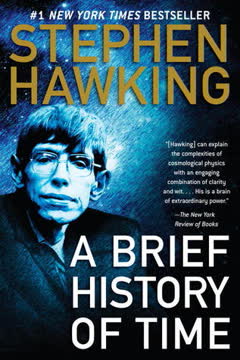


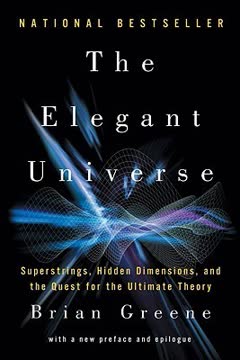
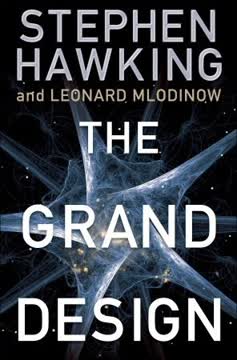
Download PDF
Download EPUB
.epub digital book format is ideal for reading ebooks on phones, tablets, and e-readers.

